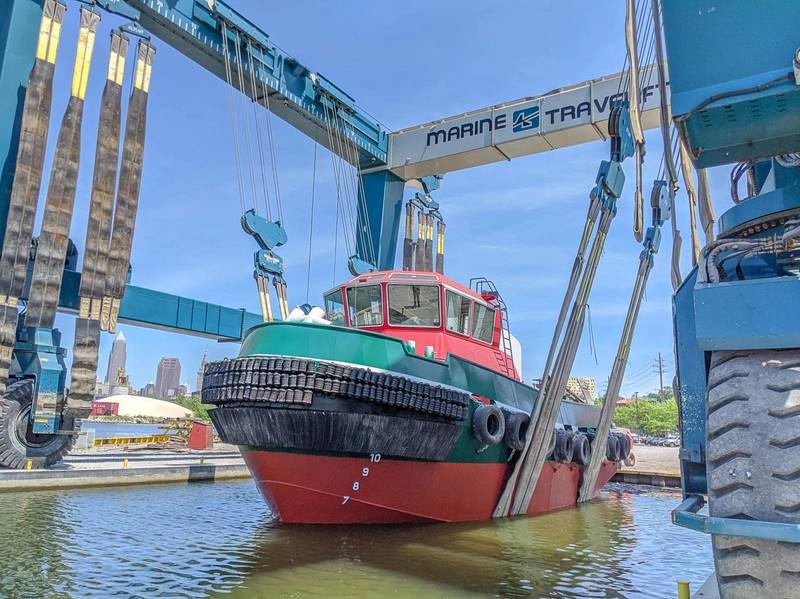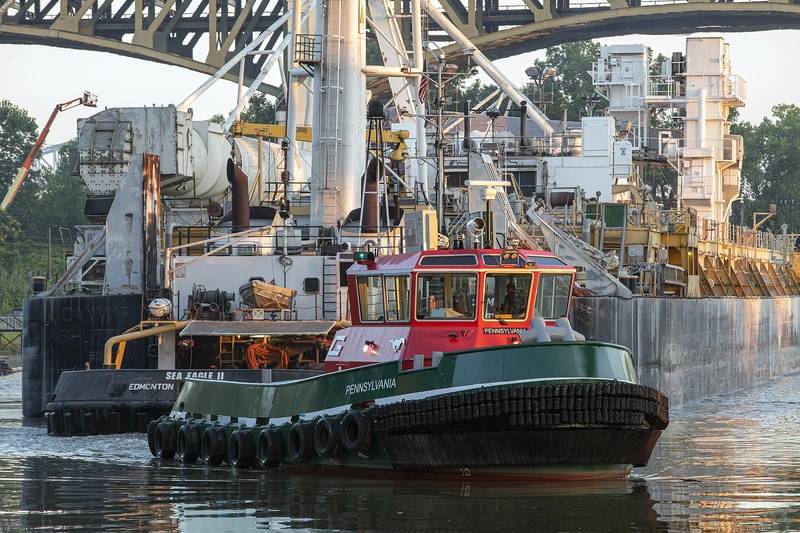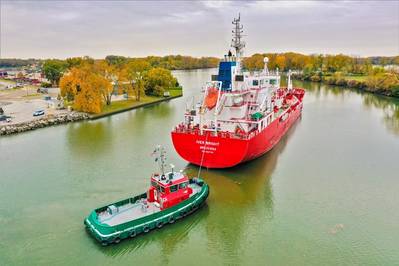Great Lakes Group: Venerable & Versatile
“…We have built our reputation job by job, boat by boat, and tow by tow, and we intend to continue to do so.”
The Great Lakes Towing Company (GLT) and the Great Lakes Shipyard are core businesses within The Great Lakes Group of Companies, based in Cleveland, on the Old River, a shipping channel that runs west from where the Cuyahoga River meets Lake Erie. Company towing operations extend from Buffalo, N.Y. in the east to Duluth, Minn. in the west. Great Lakes Towing owns and operates the largest U.S.-flagged tugboat fleet on the Great Lakes, serving more than 35 ports in all eight U.S. Great Lakes states. Services include harbor towing, docking and undocking assistance, ice breaking and inter-port towing of vessels and barges.
Great bones
The Great Lakes Group has deep roots in America’s industrial business history; almost mythic, really. Consider: in 1899 John D. Rockefeller was the founding shareholder.
Over the next century America’s Midwest states became the greatest industrial dynamo in the world. Waterborne transport was critical to that success. The Great Lakes Group has been a dominant maritime player during that entire century. Over the decades, the company continuously evolved to meet the changing demands of the agricultural, steel, and construction industries, and the needs of the ships and tug/barge units which serve those industries.
Today, The Great Lakes Towing Company (a privately owned subchapter S corporation) has about 100 full time employees. Joe Starck, who joined the company in 1991, is current president.
Many of GL’s executives have been with the company for over 20 years. Their expertise ranges from vessel design, to project management, to vessel construction and repair. “As a small company,” Starck commented, “most employees wear many hats. One core strength across our team is the ability to multitask, maintain flexibility and work well with each other across departments.” Employees hold numerous certifications documenting skills and training. Additionally, GLT’s team is involved beyond the shop floor, and contribute to advancing local maritime and community-based business issues through the American Bureau of Shipping, SNAME and the Propeller Club.
Originally established to build and service its own fleet, the Shipyard division specializes in a wide range of marine construction and repair services. The Company began offering these services to third party customers in the early 1980s. Then, in the early 1990s, services expanded to include marine fabrication and, in the early 2000s, new vessel construction was added.
 (Photo: The Great Lakes Group)
(Photo: The Great Lakes Group)
Now, the Shipyard division provides in-house expertise for designing, building and maintaining its own tugboat fleet. Its portfolio includes an extensive list of commercial and government vessels. The Shipyard also performs extensive government contracted work for many federal agencies, including U.S. Environmental Protection Agency, the Coast Guard, NOAA and many state and local governments.
Topside repair work and winter layup services are provided on any vessel, at any Great Lakes port in the U.S., customers’ docks, other deep-water berths, or alongside one of GLT’s Cleveland facilities. Drydocking and bottom work are facilitated via the Marine Travelift. Steel fabrication and winter lay-up work are also offered in Cleveland.
Smart spaces
Starck says the GLT facility itself, particularly the way it was designed and laid out, provides core operational strengths and advantages. He refers to the layout as “nimble and capable.” With the Travelift, for example, placed in service in 2011, GLT’s team can schedule and sequence multiple new construction and repair projects. The Travelift allows for emergency haulout for repairs and, perhaps more importantly, a quick return to service.
This is a busy shipyard. The Towing Company is in the process of a fleet renewal program to produce a total of ten new harbor tugs for operation in its own fleet. In 2016, the Shipyard laid the keels for Damen Stan Tug 1907 ICE. Five are complete, the sixth is under construction. The company builds to a customer’s plans, or it can provide its own designs including several from Damen. Over the years, GLT’s relationship with Jensen Maritime has also resulted in several successful tug designs, including the “Z-Class” 94-foot ASDs and “HandySize Class” 74-foot twin-screw conventional model.
 (Photo: The Great Lakes Group)
(Photo: The Great Lakes Group)
Working on workforce
Like many businesses in many locales across the Nation, The Great Lakes Group of companies work to stay on top of challenging workforce issues. “Finding good, qualified full-time shipyard employees has always been a challenge for the Towing Company,” Starck noted. “We have supplemented (our staff) with labor supply contractors for the past several years, and many of those ‘contract’ workers have been here so long, they have become fully integrated into our team. In the meantime, we are always trying to ‘grow our own’ and when we find talented candidates who have unique skills and the right experience, we generally find a place for them.”
The company is active in the workforce space. It has a continuing partnership with area schools to provide internships and on-the-job training opportunities. “This is especially true for the trades,” Starck commented. “Recruitment in such fields is an ongoing effort, something GLT maintains as a priority within its larger corporate culture.”
GLT’s education and training focus is linked with three local programs:
- At Cuyahoga Community College, the Company works with the Advanced Technology Academy Workforce, Community, & Development Division. GLT assists in the development and implementation of new technologies and has worked with the school to establish pathways for students who are interested in a career in the shipyard or maritime industry. The Company works with instructors to ensure students are receiving the most up-to-date training that reflects industry trends.
- A cooperative working agreement has been in place with the Cleveland Municipal School District’s Max S. Hayes High School for over 20 years. The Company has helped develop a program for students to obtain shipyard related training at the school, and practical on-the-job experience in the shipyard. With the opening of the Max S. Hayes’ new school building in 2016, the Company has helped to outfit state-of-the-art labs with modern equipment to train students in welding and diesel engine mechanics – skills much needed in the Tugboat and Shipyard industries.
- At Polaris Career Center, the Adult Education Welding Program serves as a great feeder program for certified welders. GLT’s Shipyard Executive team volunteers to help structure the welding curriculum and write course material.
 Joe Starck, President, The Great Lakes Group (Photo: The Great Lakes Group)
Joe Starck, President, The Great Lakes Group (Photo: The Great Lakes Group)
2020’s unique challenges
It’s a sad and obvious understatement to note that 2020 seemed to present endless and unique challenges for just about every business in every business sector. Fortunately, Great Lakes has been able to persevere. Starck said that commercial repair work was slow, likely attributable to the pandemic. On the other hand, he said there has been a steady flow of government repair work, which is expected to last through the winter.
Starck and GLT remain optimistic. As noted, the sixth Damen 1907 tug is under construction. Plus, their crystal ball hints at several commercial vessels due for drydocking and repair in 2021. And, possibly, even more: “A number of potential projects are in the pipeline,” Starck notes with anticipation, “work involving both new construction and repair.” In addition, industry investment by companies all across the Great Lakes Region is at a level not seen since the 1980s.
There are other future-focused plans. One important example: in late 2017, GLT joined Green Marine, an international, business based maritime environmental group. Green Marine has a North American based certification program. It addresses key environmental issues through 13 performance indicators. To be Green Marine certified, companies must benchmark their annual environmental performance through the program’s self-evaluation guides, have their results verified by an accredited external verifier and agree to publication of their individual results. Indicators include greenhouse gases, air emissions, spill prevention and community impact.
The Great Lakes Towing Company joined Green Marine as a vessel operator and shipyard in late 2017, the first U.S. shipyard to do so. In the past two years both the towing and shipyard operations became certified Green Marine participants. The companies continue to keep their operations within the program’s demands.
Another important new focus for GLT, again with an eye on the future, is to be ready for offshore wind – in this case Great Lakes offshore wind. GLT has provided transport services for turbine components and continues to collaborate with wind developers on logistics, maintenance and the repair services that will be necessary once offshore wind projects take hold in Lake Erie and the Great Lakes.
Recall that the Lake Erie Energy Development Company (LEEDCO) was tantalizingly close to generating power with its proposed Icebreaker wind farm, in Lake Erie, near Cleveland. The Icebreaker project was stopped at the last minute, in May, after Ohio regulators set strict limits on nighttime operations. That decision, though, was overturned in September. The project can proceed subject to plans to minimize bird and bat strikes.
When energy and environmental specialists figure out how to implement those protective moves, the Great Lakes Companies will be ready. Just like they’ve been ready to work with every other change for the past 121 years.













